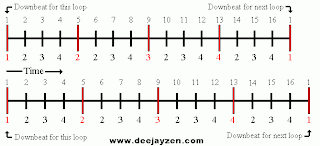Beatmatching (or Beatmaxing) is a disc jockey technique of pitch shifting or timestretching an upcoming track to match its tempo to that of the currently playing track — i.e., the kicks and snares in two house records hit at the same time when both records are played simultaneously. Beatmatching is a component of mixing which employs beatmatching combined with equalization, attention to phrasing and track selection in an attempt to make a single mix that flows together and has a good structure.
The technique was developed to keep the people from leaving the dancefloor at the end of the song. These days it is considered basic among DJs in electronic dance music genres, and it is standard practice in clubs to keep the constant beat through the night, even if DJs change in the middle.
Beatmatching is no longer considered a novelty, and new digital software has made the technique much easier to master.
The beatmaxing (or beatmatching) technique consists of the following steps:
While a record is playing, beatmatch a new record to it, using headphones for monitoring. Use gain (or trim) control on the mixer to match the levels of the two records.
Restart and slip-cue the new record at the right time, begin the new record on beat with the record currently playing. Pay attention to track structures; careful phrasing can make the mix seamless.
If the beat on the new record hits before the beat on the current record then the new record is too fast, reduce the pitch and manually slow the speed of the new record to bring the beats back in sync.
If the beat on the new record hits after the beat on the current record then the new record is too slow, increase the pitch and manually increase the speed of the new record to bring the beats back in sync.
Continue this process until the two records are in sync with each other, it can be difficult to sync the two records perfectly, so manual adjustment of the records is necessary to maintain the beat synchronization.
Before fading in the new track, check that the beats of two tracks match by listening to both channels together in the headphones, as the sound from the speakers can reach you with a delay.
Gradually, fade in parts of the new track while fading out the old track. While in the mix, ensure that the tracks are still synchronized, adjusting the records if needed.
The fade can be repeated several times, for example, from the first track, fade to the second track, then back to first, then to second again.
The pitch and tempo of a track are normally linked together: spin a disc 5% faster and both pitch and tempo will be 5% higher. However, some modern DJ software can change pitch and tempo independently using time-stretching and pitch-shifting, allowing harmonic mixing.
Beatmatching was invented by Francis Grasso in the late 1960s and early 1970s. Initially he was counting the tempo with a metronome and looking for records with the same tempo. Later a mixer was built for him by Alex Rosner which let him listen to any channel in the headphones independently of what was playing on the speakers; this became the defining feature of DJ mixers. That and turntables with pitch control enabled him to mix tracks with different tempo by changing the pitch of the cued (redirected to headphones) track to match its tempo with the track being played by ear. Essentially, the technique he originated hasn't changed since.
These days beatmatching is considered central to DJing, and features making it possible are a requirement for DJ-oriented players. In 1978, the Technics SL-1200MK2 turntable was released, whose comfortable and precise sliding pitch control and high torque direct drive motor made beatmatching easier and it became the standard among DJs. With the advent of the compact disc, DJ-oriented Compact Disc players with pitch control and other features enabling beatmatching (and sometimes scratching), dubbed CDJs, were introduced by various companies. More recently, software with similar capabilities has been developed to allow manipulation of digital audio files stored on computers using turntables with special vinyl records (e.g. Final Scratch, M-Audio Torq, Serato Scratch Live) or computer interface (e.g. Traktor DJ Studio, Mixxx, Virtual DJ). Other software including algorithmic beatmatching is Ableton Live, which allows for realtime music manipulation and deconstruction, or Mixmeister, a DJ Mixset creation tool. Freeware software such as Rapid Evolution can detect the beats per minute and determine the percent BPM difference between songs.
The change from pure hardware to software is on the rise, and big DJs are introducing new equipment to their kits such as the laptop, and dropping the difficulty of carrying hundreds of CDs with them. The creation of the mp3-player allowed DJs to have an alternative tool for DJIng. Limitations with mp3-player DJing equipment has meant that only second generation equipment such as the IDJ2 or the Cortex Dmix-300 have the pitch control that alters tempo and allows for beatmatching on a digital music player. However, recent additions to the Pioneer CDJ family, such as the CDJ-2000, allow mp3-player and other digital storage devices (such as external hard drives, SD cards and USB memory sticks) to be connected to the CDJ device via USB. This allows the DJ to make use of the beatmatching capabilities of the CDJ unit whilst playing digital music files from the mp3-player or other storage device.
Pioneer's latest CDJ-2000nexus player has a "Beat-Sync" feature which automatically adjusts the tempo between tracks being mixed so the DJ no longer needs to spend time & effort matching beats. This has caused some controversy in the DJ industry since almost anyone can beat-match thanks to the new function.






